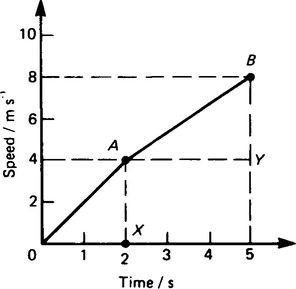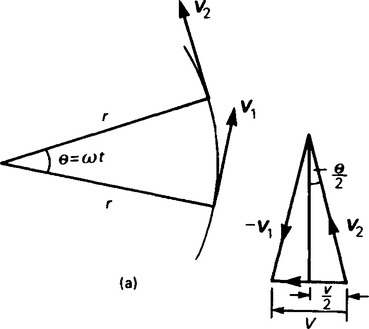Acceleration and force
Publisher Summary
This chapter focuses on acceleration and force. Acceleration is the rate of change of speed or velocity with time. A graph of speed (scale on the vertical axis), against time (scale on the horizontal axis) is called a speed-time graph. In general, the slope of a line on a speed–time graph gives the acceleration. If a dense object, such as a stone, is dropped from a height, called free fall, it has a constant acceleration of approximately 9.8 meters per second squared. However, if free fall takes place in air, dense objects have the approximately constant acceleration of 9.8 meters per second squared over short distances, but objects that have a low density, such as feathers, have little or no acceleration. On the other hand, when an object is pushed or pulled, a force is applied to the object. The unit of force is the Newton (N) and is defined in terms of mass and acceleration. One Newton is the force required to give a mass of one kilogram an acceleration of one meter per second squared.
1. Acceleration is the rate of change of speed or velocity with time. The average acceleration, a, is given by:
The usual units are metres per second squared (m/s2 or m s-2). If u is the initial velocity of an object in m/s, v is the final velocity in m/s and t is the time in seconds elapsing between the velocities of u and v, then
2. A graph of speed (scale on the vertical axis), against time (scale on the horizontal axis) is called a speed-time graph. For the speed-time graph shown in Figure 25.1, the slope of line OA is given by AX/OX. AX is the change in velocity from an initial velocity u of zero to a final velocity, v, of 4 metres per second. OX is the time taken for this change in velocity, thus


i.e the acceleration is 2 m/s2.
Similarly, the slope of line AB in Figure 25.1 is given by BY/AY, that is, the acceleration between 2 and 5 s is
In general, the slope of a line on a speed-time graph gives the acceleration.
3. If a dense object such as a stone is dropped from a height, called free fall, it has a constant acceleration of approximately 9.8 metres per second squared. In a vacuum, all objects have this same constant acceleration vertically downwards, that is, a feather has the same acceleration as a stone. However, if free fall takes place in air, dense objects have the approximately constant acceleration of 9.8 metres per second squared over short distances, but objects which have a low density, such as feathers, have little or no acceleration.
4. For bodies moving with a constant acceleration, the average acceleration is the constant value of the acceleration, and since from para. 1,
u is the initial velocity in m/s,
v is the final velocity in m/s,
When symbol ‘a’ has a negative value, it is called deceleration or retardation. The equation, v= u+ at is called an equation of motion.
5. When an object is pushed or pulled, a force is applied to the object. This force is measured in newtons, (N). The effects of pushing or pulling an object are:
(i) to cause a change in the motion of the object, and
(ii) to cause a change in the shape of the object.
If a change occurs in the motion of the object, that is, its speed changes from u to v, then the object accelerates. Thus, it follows that acceleration results from a force being applied to an object. If a force is applied to an object and it does not move, then the object changes shape, that is, deformation of the object takes place. Usually the change in shape is so small that it cannot be detected by just watching the object. However, when very sensitive measuring instruments are used, very small changes in dimensions can be detected.
6. A force of attraction exists between all objects. The factors governing the size of this force are the masses of the objects and the distances between their centres,
Thus, if a person is taken as one object and the earth as a second object, a force of attraction exists between the person and the earth. This force is called the gravitational force and is the force which gives a person a certain weight when standing on the earth’s surface. It is also this force which gives freely falling objects a constant acceleration in the absence of other forces.
7. To make a stationary object move or to change the direction in which the object is moving requires a force to be applied externally to the object. This concept is known as Newton’s first law of motion and may be stated as:
8. Since a force is necessary to produce a change of motion, an object must have some resistance to a change in its motion. The force necessary to give a stationary pram a given acceleration is far less than the force necessary to give a stationary car the same acceleration. The resistance to a change in motion is called the inertia of an object and the amount of inertia depends on the mass of the object. Since a car has a much larger mass than a pram, the inertia of a car is much larger than that of a pram.
9. Newton’s second law of motion may be stated as:
‘the acceleration of an object acted upon by an external force is proportional to the force and is in the same direction as the force.’
or force = a constant × acceleration, this constant of proportionality being the mass of the object, i.e.
The unit of force is the newton (N) and is defined in terms of mass and acceleration. One newton is the force required to give a mass of 1 kilogram an acceleration of 1 metre per second squared. Thus:
F is the force in newtons (N), m is the mass in kilograms (kg) and a is the acceleration in metres per second squared (m/s2), i.e.
10. Newton’s third law of motion may be stated as:
Thus, an object on, say, a table, exerts a downward force on the table and the table exerts an equal upward force on the object, known as a reaction force or just a reaction. When an object is accelerating, the force due to the inertia of the body (F= ma) is a reaction force acting in the opposite direction to the motion of the object.
11. When an object moves in a circular path at constant speed, its direction of motion is continually changing and hence its velocity (which depends on both magnitude and direction) is also continually changing. Since acceleration is the
the object has an acceleration. Let the object be moving with a constant angular velocity of ω and a tangential velocity of magnitude v and let the change of velocity for a small change of angle of θ (=ωt) be V.
The vector diagram is shown inFigure 25.2(b) and since the magnitudes of v1 and v2 are the same, i.e. v, the vector diagram is also an isosceles triangle.

Bisecting the angle between v2 and v1 gives:
 (1)
(1)
For small angles, ![]() is very nearly equal to unity.
is very nearly equal to unity.
That is, the acceleration a is v2/r and is towards the centre of the circle of motion (along V). It is called the centripetal acceleration. If the mass of the rotating object is m, then by Newton’s second law the centripetal force is mv2/r, and its direction is towards the centre of the circle of motion.
